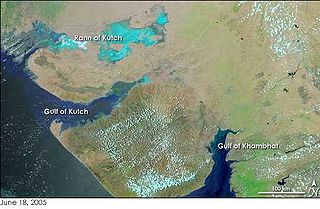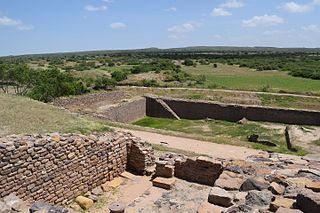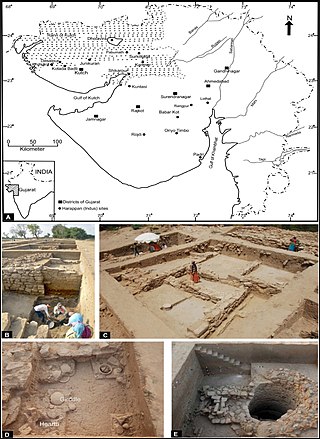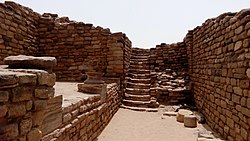
The Indus Valley Civilisation (IVC), also known as the Indus Civilisation, was a Bronze Age civilisation in the northwestern regions of South Asia, lasting from 3300 BCE to 1300 BCE, and in its mature form from 2600 BCE to 1900 BCE. Together with ancient Egypt and Mesopotamia, it was one of three early civilisations of the Near East and South Asia, and of the three, the most widespread, its sites spanning an area including much of modern day Pakistan, northwestern India and northeast Afghanistan. The civilisation flourished both in the alluvial plain of the Indus River, which flows through the length of Pakistan, and along a system of perennial monsoon-fed rivers that once coursed in the vicinity of the Ghaggar-Hakra, a seasonal river in northwest India and eastern Pakistan.

Lothal was one of the southernmost sites of the ancient Indus Valley civilisation, located in the Bhal region of the Indian state of Gujarat. Construction of the city is believed to have begun around 2200 BCE.

Rakhigarhi or Rakhi Garhi is a village and an archaeological site in the Hisar District of the northern Indian state of Haryana, situated about 150 km northwest of Delhi. It is located in the Ghaggar River plain, some 27 km from the seasonal Ghaggar river, and belonged to the Indus Valley civilisation, being part of the pre-Harappan, early Harappan, and the mature phase of the Indus Valley Civilisation.

The Great Rann of Kutch is a salt marsh in the Thar Desert in the Kutch District of Gujarat, India. It is about 7500 km2 in area and is reputed to be one of the largest salt deserts in the world. This area has been inhabited by the Kutchi people.

Kutch district, officially spelled Kachchh, is a district of Gujarat state in western India, with its headquarters (capital) at Bhuj. Covering an area of 45,674 km2, it is the largest district of India. The area of Kutch is larger than the entire area of other Indian states like Haryana (44,212 km2) and Kerala (38,863 km2), as well as the country of Estonia (45,335 km2). The population of Kutch is about 2,092,371. It has 10 talukas, 939 villages and 6 municipalities. The Kutch district is home to the Kutchi people who speak the Kutchi language.

The Little Rann of Kutch is a salt marsh which is part of the Rann of Kutch in Kutch district, Gujarat, India.

Dholavira is an archaeological site at Khadirbet in Bhachau Taluka of Kutch District, in the state of Gujarat in western India, which has taken its name from a modern-day village 1 kilometre (0.62 mi) south of it. This village is 165 km (103 mi) from Radhanpur. Also known locally as Kotada timba, the site contains ruins of a city of the ancient Indus Valley civilization. Earthquakes have repeatedly affected Dholavira, including a particularly severe one around 2600 BCE.
Rangpur is an ancient archaeological site in Surendranagar district near Vanala on Saurashtra peninsula in Gujarat, western India. Lying on the tip between the Gulf of Khambhat and Gulf of Kutch, it belongs to the period of the Indus Valley civilization, and lies to the northwest of the larger site of Lothal. It is the type site for the Rangpur culture, a regional form of the late phase of the Indus Valley Civilization that existed in Gujarat during the 2nd millennium BCE.
Farmana Khas or Daksh Khera is an archaeological site in Meham block of Rohtak district in northern Indian state of Haryana spread over 18.5 hectares. It is located near the village of Farmana Khas, about 15 kilometers from the Rohtak-Hissar highway and 60 kilometres from Delhi. It is significant particularly for its burial site, with 70 burials, of the Mature Harappan period (2500–2000 BC) and fairly recent addition to Indus Valley civilisation sites excavated in India.

The Rann of Kutch is a large area of salt marshes that span the border between India and Pakistan. It is located mostly in the Kutch district of the Indian state of Gujarat, with a minor portion extending into the Sindh province of Pakistan. It is divided into the Great Rann and Little Rann. It used to be a part of the Arabian Sea, but it then dried up, leaving behind the salt, which formed the Rann of Kutch. The Luni flowed into the Rann of Kutch, but when the Rann dried up, the Luni was left behind, which explains why the Luni does not flow into the Arabian Sea today.
The Kutch Desert Wildlife Sanctuary is situated in the Great Rann of Kutch, Kutch district, Gujarat, India. It was declared a sanctuary in February 1986. It is the largest Wildlife Sanctuary in India regarding its size.

Khirasara is an archaeological site belonging to the Indus Valley civilization. This site is located in Nakhatrana Taluka of Kutch district in the western Indian state of Gujarat. It is located on the bank of Khari river. The site is 85 km from Bhuj, the district headquarters.
Kerala-no-dhoro(કેરળ-નો-ઢોરો), also known as Padri, is an archaeological site in Gujarat, India. Belonging to the Indus Valley civilisation, it is located on the southern coast of Kathiawar region. Dating from 3699-3792 B.C. known as Padri Culture or Early Harappan period a part of Sorath Harappan, Indus Valley culture.
Pabumath is an Indus Valley civilisation archaeological site near Suvai village in Rapar Taluka of Kutch district, Gujarat, India.
Ravindra Singh Bisht is an Indian archaeologist, known for his scholarship on Indus valley civilization and efforts to conserve Indian national monuments. He was honoured by the Government of India, in 2013, by bestowing on him the Padma Shri, the fourth highest civilian award, for his contributions to the field of archaeology.
Meruda Takkar is a landform located north of Khadir Bet in the Great Rann of Kutch, Kutch district, Gujarat, India. It has a presence of alkali feldspar syenite rocks which are of either Precambrian or Pre-Deccan Mesozoic plutonic origin. It is described as a hill, an island, an outcrop as well as a monadnock.
Shambhudan Gadhvi is a former master clerk and amateur geologist from Gujarat who discovered the Indus valley site of Dholavira in the early 1960s.
The Road to Heaven is a highway located in the Kutch District of Gujarat, India. It spans approximately 30 kilometers through the Great Rann of Kutch, providing stunning views of India's largest salt plain. This road forms part of the national highway connecting Ghaduli to Santalpur and has become renowned for its scenic beauty and the distinctive driving experience it provides.














